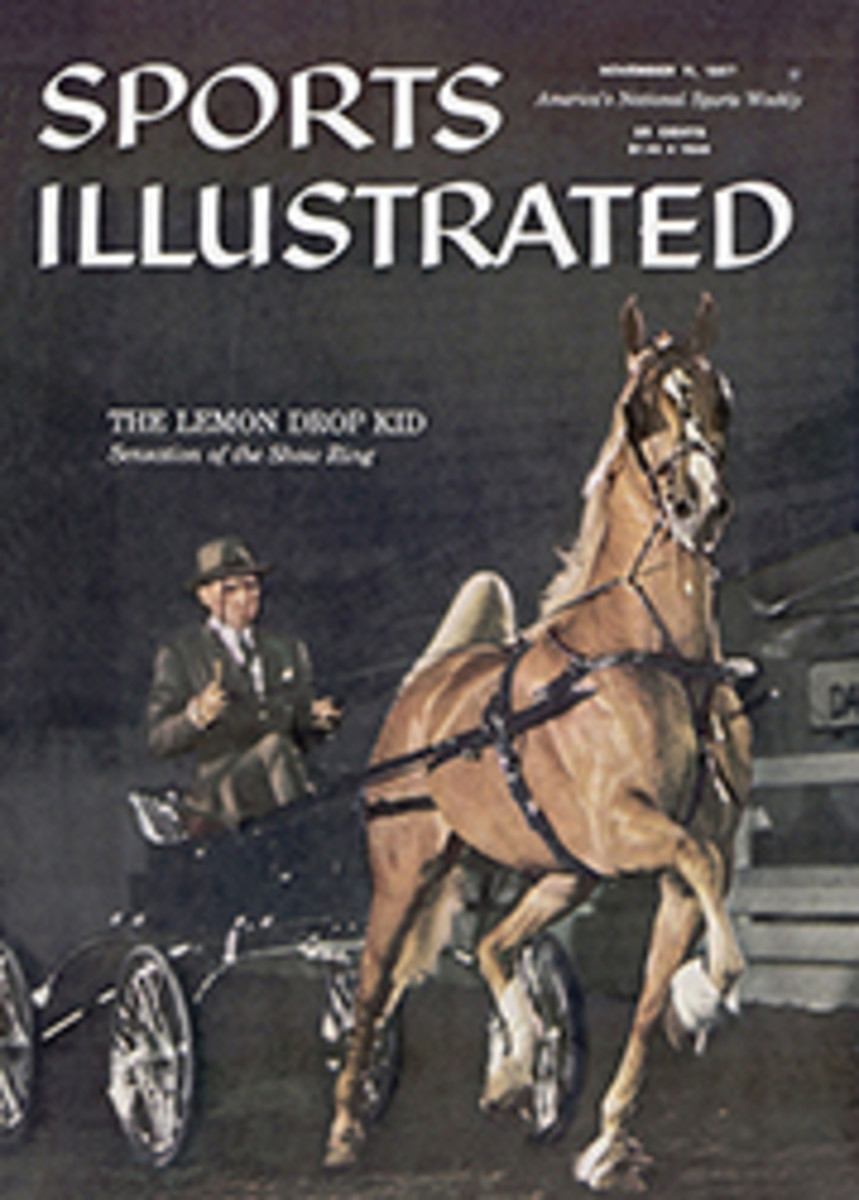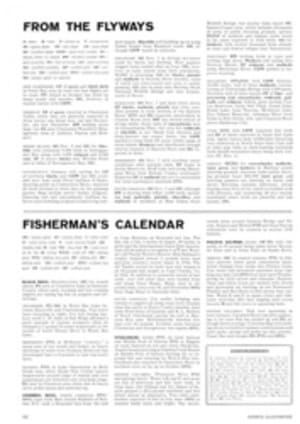
FOOTBALL IN THE BACKYARD
High school football is one of the happiest continents in the world of sport. It is the area of the unexpected. It can make you laugh till your belly hurts but it can also make you suffer the anguish of the bereaved. It is the neighbor's dog running across the field in the middle of that 99-yard touchdown run. It is the pretty baton twirler who misses the catch five times in a row at the half-time show and the exuberant musician who punches a hole through the band's only bass drum during the fight song. It is Junior out on the field missing tackles, forgetting signals and blocking his own teammates with all the élan of a spring foal which has just found its legs. It is that moment when the kid next door, the one with the two left feet, is suddenly in the wrong place at the right time and saves the day for hundreds of squealing bobby-soxers who will worship him in memory evermore for the winning touchdown.
It is backyard football, but it is such a bargain of fun that 60 million people will pay this year to see 666,000 teen-age players do things on a football field that would make Walter Camp roll over in his grave—with delight.
Hempstead High School on Long Island, whose football delirium is shown on the following four pages, is typical of the teen-age tempest which explodes throughout the country each fall. At Hempstead everyone has fun, even the coach, Bob Schussler, who at $800 a season can't afford to get too upset. Schussler is Hempstead's science teacher, and he coaches the team on the side.
"We don't feel we have to make money, or draw big crowds or even win ball games," says Hempstead's athletic director, Alfred Vorhies. "We draw maybe two or three thousand if the weather's nice, but really we're just out to give the kids a good time. And boy, they have it."
The ebullience at Hempstead is endemic in all high school football. The town or the neighborhood is proud of its squad. The team carries the community honor on the football field. In some cases a community will let chauvinism run away with it and the high school team becomes an important symbol of identification. It becomes very urgent that the community have the very best football team it can possibly have. One case in point is Massillon, Ohio, where the local team is just about all there is for athletic entertainment during the autumn months.
Lee Tressel, head coach at Massillon High School, stood on the bluff adjacent to Massillon's 22,000-seat brick and concrete stadium. He gazed on the sprawling practice field where his seven assistants were getting the afternoon practice session started. Already they had split the team into five units and had begun double-team blocking drills.
"What makes us so good?" he asked himself.
"Well, I guess you could say there's a football tradition here in Massillon that's as old as the game. Ever since Paul Brown was coach here we've had winning teams. It gave this town something to be proud of. A kid grows up here with a football in his hands from the time he's big enough to hold one. Fathers live for the day when their sons will be old enough and big enough to play on the varsity. It's kind of an honor for the fathers, you know. This pride for the team is one of the biggest reasons we're so good.
"Look at these kids," he said, pointing to a beefy youngster playing middle guard in one of the cluster of scrimmages taking place all around. "That one there, he's 15, a sophomore. Weighs 225, stands about 6 feet 2. That's why we're so good, too."
Tressel's material comes from three junior high schools in Massillon. Each of the junior highs has two coaches and Tressel has the authority to hire and fire them. In effect, they are part of his staff. When a football player comes to Massillon High he has already had three years of coaching under the Tressel system. What is a coach worth to a system like this? "I make $8,000 a year," said Tressel. "If I win the state championship I get a new car. If I don't I still get awfully nice presents at Christmas."
The Massillon football system is run on a very businesslike basis. A giant booster club, composed of alumni and influential businessmen in the town, foots the bills for game movies (in color), whirlpool baths, giant rallies and—so the story goes—special talent. It is common knowledge among other coaches in the state that Massillon boosters have moved entire families into town, placed Pop in a fine-paying job just so Sonny, a good-looking football prospect, would be eligible to attend Massillon. The team takes in more than $100,000 a season at the gate.
If money, talent and high-priced coaches make for top-notch football at Massillon, they do that and more at Abilene, Texas, where the city's high school team is the number one boast of the chamber of commerce. In beating Big Spring 32-0 in its last game the team chalked up its 44th consecutive victory to set a new national record.
The current protector of this athletic dynasty is 39-year-old Chuck Moser, a native of Missouri. When Moser took over in 1953 his employers showed him they wanted winning football by starting him out at college-scale salary. Moser quickly showed Abilene it had the right man by guiding the team to the Texas state championship in 1954, 1955 and 1956. Moser is a compact, wiry man who walks hunched forward as if ready to spring. His voice is deep and his eyes go over you in a friendly but appraising inspection. "We don't import players or move families," says Moser, "but we do have a football program that beats almost anything you might find outside of Texas.
"We have over 800 kids playing football in 18 elementary schools scattered around town. They all come on to Abilene High. It's strictly recreation, really, but we like to win, too. Every school our size in the state has the same type of program, so I guess we just run it better.
"Abilene didn't win much in the '40s, you know. I guess the people were getting kind of hungry around here. When we started winning, well, we just kept defeat down on the ground. You win 44 games and people get the idea that the kids on your team are supermen or over-age or ringers. It's just not true. Look, the kids on this team average 16.9 years. Is that old? The average weight is 180. Is that so big? The reason these kids are good is that they want to be good. They work at it, and they work hard.
"Sure, we've got exceptional facilities. We've got a stadium that seats 11,000, and the city just passed a $750,000 bond issue to build us a new one that'll seat about 20,000. We've got support, too. Fans fill the field week in and week out. One year when we played in Fort Worth for the state championship 7,000 people from Abilene traveled 150 miles just to see the game.
"The school system gives me the money to get good coaches. My salary is $10,000 flat. Last year at the football banquet members of our booster club gave me $9,000 cash. I kept $3,000 of it and split the rest with my seven assistants. That's $13,000. And I've got a weekly television show during football season that pays me pretty well.
"With all the advantages I have here in town, all the friends, how could I accept the head coach's job at Missouri last year? In the first place they offered me only $10,300.
"I guess in a way you could say we're a football factory. There's hardly a day goes by when some college coach isn't visiting, trying to find prospects. But the kids on this team are students. They have to be or they don't play.
"Right now I've got 29 Abilene boys playing college ball—all on scholarships. Bobby Jack Oliver, tackle at Baylor, he's one of them. Glynn Gregory, the kid everyone was chasing last year, he's at SMU. Got them all over the state. Football makes money here. We play 14 games a year if we get to the final playoffs for the championship—10 regular season and four playoffs. In the final playoff in 1955 we took in $42,000."
Ironically, the $42,000 taken in by Abilene in a single game could support football at Hempstead for the next 15 years. The Long Island school spends about $2,400 a year supporting the sport.
At New Trier High School in Kenilworth, a Chicago suburb, the cost of the football program ran $11,914.90 last year. Yet football at New Trier is conducted on still a different level from either Massillon or at Abilene. The school is, first of all, a township school encompassing Wilmette, Kenilworth, Winnetka and Glencoe—all extremely wealthy suburban areas. Its student body is college size, 3,389, almost twice as large as either Massillon or Abilene.
No one who tries out for football at New Trier is ever cut from the squad. "As long as they show for practice," says Coach Walter Aschenbach, "they're on the team—or one of the teams." So Aschenbach creates as many squads as he has players to fill them. New Trier maintains freshman, sophomore, junior varsity and varsity football teams and, if needed, each of these has an A squad and a B squad. "I've got the coaches to go around." says Aschenbach, "so why not give everyone a chance to play. Besides, it makes for a good farm system."
Aschenbach has a problem when it comes to advising his graduates about choosing a college. "I tell them to pick their school as though they were never going to play another game of football," he says. "And I discourage them looking for scholarships. I don't think a kid whose old man makes $50,000 a year should be asking for handouts. If a kid comes to school here at New Trier, his old man is loaded."
"We're on a wholesome basis here," Aschenbach asserts proudly. "Athletics—football if you wish—are part of the educational setup. The tail does not wag the dog. I agree with the Ivy League concept of sports. Let's keep it amateur but let's make it as good as we can."
Most of the athletes from New Trier go on to eastern schools—many to Yale, Harvard and Princeton. New Trier footballers have supplied Yale with some of its finest talent in recent years, with such stars as Al Ward, 1956 halfback, and Mike Cavallon, an end on this year's team.
Of the four systems, which is the best? Hempstead, Massillon, Abilene or New Trier?
"None," says Henry Steele Commager, Columbia University's outspoken professor of American history. High school football, according to Commager, is nothing more than "a burlesque show on the playing field."
"We would not expect—we would not permit—our daughters to entertain the community in a night club or burlesque show. There is no reason why we should permit our sons to entertain the community by what are in effect burlesque performances on the playing field."
Commager suggested this solution:
"Take away the dollar sign. Do away with paid coaches and the pressure for victory will disappear. Do away with paid admission and the dependence of other sports on football and basketball will disappear."
Yes, and so would Massillon, Abilene and possibly even rich New Trier.

